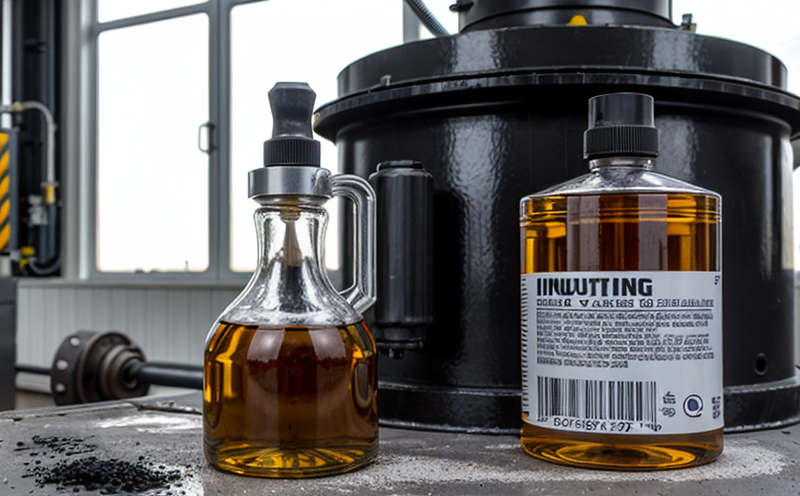DIN 51352 Oxidation Stability Testing of Lubricants
The DIN 51352 standard is an internationally recognized method used to assess the oxidative stability of lubricating oils and additives. This test is crucial for ensuring that industrial lubricants maintain their performance under operational conditions, particularly in environments where oxidation can lead to degradation and reduced service life.
Understanding the importance of this test involves recognizing how it contributes to overall product quality and reliability. In industrial settings, prolonged exposure to heat, friction, and contaminants can accelerate the oxidation process. This reaction not only affects the chemical structure but also leads to the formation of harmful by-products that could compromise lubricant effectiveness.
The DIN 51352 test evaluates the resistance of a lubricant sample to oxidative degradation over time under controlled conditions. By subjecting the lubricant to high temperatures and air, it simulates real-world operating conditions where oxidation is most likely to occur. The key parameters measured include viscosity changes, acid number (AN), and the formation of sludge.
Viscosity change is a critical indicator as it directly impacts the lubricant's ability to perform its intended function efficiently. Acid number provides insight into the presence of organic acids, which are formed during oxidation processes and can indicate contamination or aging. Sludge formation signifies the potential for increased wear in machinery due to insoluble deposits that may form.
Accurate testing is essential for maintaining quality standards and ensuring compliance with international regulations such as ISO 12208-3. This standard outlines procedures for measuring oxidation stability using a specific procedure based on DIN 51352, which has been adopted globally due to its reliability in predicting the potential lifespan of lubricants.
The test setup typically involves placing a specified quantity of the lubricant sample into a sealed container and exposing it to controlled temperature and air conditions for an extended period. At regular intervals, samples are withdrawn from the container, analyzed, and compared against initial baseline data.
This rigorous testing ensures that industrial lubricants meet stringent quality requirements, thereby protecting equipment integrity and operational efficiency. By adhering to this standard, manufacturers can enhance their reputation in the market by offering products known for superior performance and reliability.
Scope and Methodology
| Parameter | Description |
|---|---|
| Sample Volume | 10 mL of lubricant is used for the test. |
| Temperature | The sample is exposed to 95°C ± 2°C. |
| Time Duration | The exposure lasts for 8 hours. |
| Apparatus | A DIN 51352-compliant oxidation stability apparatus is used. |
The test begins by preparing the lubricant sample according to specified procedures. The prepared sample is then placed into a sealed container within an oven set at 95°C ± 2°C for eight hours. During this period, the sample undergoes controlled oxidation in an atmosphere of air.
After the exposure period ends, the sample is removed and analyzed immediately using standard analytical techniques such as viscosity measurement, acid number determination, and sludge formation assessment. These analyses are performed to quantify any changes that have occurred due to the oxidation process.
The results from these tests provide valuable insights into the oxidative stability of the lubricant. They help in identifying potential issues early on, allowing for timely adjustments or improvements in formulation if necessary. Compliance with DIN 51352 ensures consistency and reliability across all batches produced by manufacturers adhering to this standard.
Quality and Reliability Assurance
- Regular calibration of testing equipment to ensure accuracy.
- Use of certified reference materials for consistent baseline measurements.
- Adherence to strict quality control procedures during sample preparation.
- Detailed documentation of all test parameters and results for traceability.
- Continuous training of personnel involved in the testing process.
The DIN 51352 Oxidation Stability Test is a cornerstone in ensuring consistent product quality. By implementing robust QA measures, laboratories can guarantee that every batch tested adheres to stringent international standards like ISO and ASTM. Regular calibration ensures that all equipment used remains accurate throughout its operational life.
Certified reference materials provide stable baselines against which test results can be compared reliably. This approach enhances comparability between different batches or even different laboratories, promoting consistency across the industry. Detailed documentation is crucial for maintaining a record of each test conducted, ensuring that any discrepancies can be traced back to specific factors.
Continuous training keeps personnel up-to-date with current best practices and emerging technologies in analytical techniques. This ongoing education helps maintain high standards of performance within the laboratory environment. Ultimately, these QA protocols contribute significantly towards building trust among customers who rely on accurate data from such tests for decision-making purposes.
Environmental and Sustainability Contributions
The DIN 51352 Oxidation Stability Testing plays a pivotal role in promoting environmental sustainability by ensuring that industrial lubricants perform optimally throughout their lifecycle. By preventing premature degradation, these tests help reduce waste generation associated with frequent replacement of ineffective lubricants.
Optimizing lubricant performance through rigorous testing contributes directly to energy efficiency improvements within manufacturing processes. When machines operate smoothly and efficiently thanks to high-quality lubrication, less power is required for similar tasks, leading to lower operational costs and reduced carbon emissions.
Laboratories conducting DIN 51352 tests also play an important role in fostering sustainable practices by providing credible data that informs product development decisions aimed at enhancing environmental friendliness. For instance, identifying lubricants with enhanced oxidative stability allows manufacturers to extend the service life of their products, thus reducing the need for frequent replacements.
Moreover, compliance with international standards like DIN 51352 encourages transparency in manufacturing processes, which is vital for building consumer confidence and trust. In an era where sustainability is increasingly becoming a key consideration for businesses, adhering to such standards demonstrates commitment towards responsible practices.





